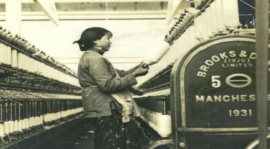Seminario 24/07 – Lei Shi (Universidad Autónoma de Barcelona): Reconfiguration of China’s occupational structure during early industrialization, 1900-1937
Información
- Ponente: Lei Shi (Universidad Autónoma de Barcelona)
- Fecha: 09/May/2024 - 12:00 horas
- Lugar: Sala de seminarios de Economía aplicada (Facultad de Economía y Empresa) - Universidad de Murcia

The debate on the ‘Great Divergence’ paid little attention to changes in China’s occupational structure. According to previous research, the agricultural sector accounted for around 80 per cent of the labour force until the Reform and Opening-Up from 1980s, and the share of modern industries in the Chinese economy was trivial. However, the first and significant industrialization had already started in China during the first three decades of the 20th Century, closely associated with the rise and expansion of major treaty ports. In particular, Shanghai experienced the fastest growth and industrialization during this period, quickly becoming China’s industrial and trade center. As a result, almost 3 million of rural laborers migrated to Shanghai during 30 years, transforming the city into one of the world’s largest metropolises, and changing the occupational structure and even the economic structure of China.
The paper reconstructs and analyzes the occupational distribution in Shanghai and Lower Yangzi region during early 20th century. It shows the fast increase of occupations in industry and services in Shanghai, and the growth and concentration of women in industrial sectors (70% of total workers). The comparison of the economic and occupational structures of the original places of the immigrants in Shanghai proves the shift of the occupations from the agriculture to the secondary and tertiary industries. In some regions (especially Jiangnan) with high rural household handicrafts, the occupational structure was also deeply affected by the modern industries and global economy, the labors had to leave the rural areas to work in manufacturing factories and services in big cities. The massive demographic and occupational structure changes show that Shanghai led China’s early industrialization and has become the driving force of China’s modernization.

